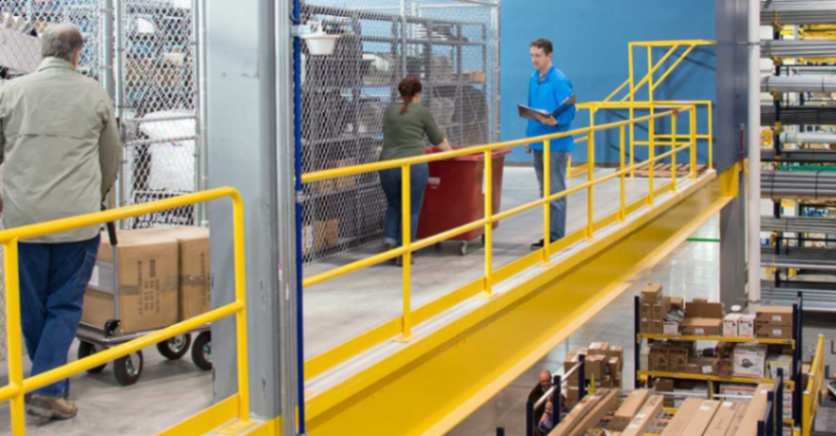Toeboards are usually 4 inches high and are used on landings and balconies. They are an important safety feature, designed to prevent tools, debris, or other objects from falling off edges, which could potentially cause injuries to people below. These boards help ensure a safer environment, particularly in construction sites or areas with elevated platforms.
What is a toe board: What is it used for?
A toe board is a safety feature used in construction and various industrial settings. It is a low, vertical barrier installed along the edges of elevated platforms, scaffolds, and walkways. Typically, toe boards are made of wood, metal, or plastic and are around 4 inches high.
Purpose and Uses of a Toe Board:
1. Preventing Falling Objects: The primary function of a toe board is to prevent tools, materials, and other objects from falling off elevated work surfaces. This helps protect workers below from potential injuries caused by falling debris.
2. Enhancing Worker Safety: Toe boards act as a physical barrier that can prevent workers from accidentally stepping off the edge of platforms or scaffolds, reducing the risk of falls.
3. Compliance with Safety Regulations: Many safety standards and regulations, such as those from the Occupational Safety and Health Administration (OSHA) in the United States, require the installation of toe boards in specific situations. Compliance with these regulations helps ensure a safe working environment.
4. Supporting Other Safety Features: Toe boards often work in conjunction with other safety measures, such as guardrails and safety nets, to provide comprehensive fall protection on construction sites and industrial areas.
In summary, toe boards are essential safety components that help prevent accidents and injuries by stopping objects and people from falling off elevated work areas. Their installation is a simple yet effective way to enhance workplace safety and comply with regulatory requirements.
Understanding Toeboards
· A toeboard is a safety feature commonly used in construction and various industrial settings to enhance workplace safety. Here’s an easy-to-understand explanation of what Toeboards are and why they are important.
· Primary Function: Toeboards stop tools, materials, and other objects from accidentally falling off the edge of elevated surfaces.
· Safety: This is crucial for protecting workers and equipment below from potential harm caused by falling debris
· A toeboard is a safety feature commonly used in construction and various industrial settings to enhance workplace safety. Here’s an easy-to-understand explanation of what Toeboards are and why they are important:
· What is a Toeboard?
· A toeboard is a low, vertical barrier installed at the edge of an elevated surface, such as a platform, scaffold, or walkway. They are typically made from materials like wood, metal, or plastic and are usually around 4 inches high, though the exact height can vary based on specific regulations and requirements.
· Purpose and Uses of Toeboards:
· Preventing Falling Objects:
· Primary Function: Toeboards stop tools, materials, and other objects from accidentally falling off the edge of elevated surfaces.
· Safety: This is crucial for protecting workers and equipment below from potential harm caused by falling debris.
· Enhancing Worker Safety:
· Barrier: baseboard act as a physical barrier that helps prevent workers from inadvertently stepping or slipping off the edge of platforms or scaffolds.
· Visibility: They serve as a visual reminder for workers to be cautious when near edges.
· Compliance with Safety Regulations:
· Regulatory Requirements: Safety organizations like OSHA (Occupational Safety and Health Administration) often require Toeboards in specific situations to ensure a safe working environment.
· Standards: Installing Toeboards helps businesses comply with these safety standards and avoid penalties.
· Supporting Other Safety Features:
· Combined Protection: Toeboardsare usually used along with other safety measures, such as guardrails and safety nets, to provide comprehensive protection against falls and falling objects.
· Real-World Example:
· Imagine a construction site where workers are building a high-rise structure. They often use scaffolds to work at various heights. Without baseboard, tools and materials could easily be knocked off these elevated surfaces, posing a serious risk to anyone below. By installing baseboard, the site managers significantly reduce the chances of such accidents, creating a safer working environment for everyone involved.
· Conclusion:
· Baseboard might seem like a small and simple addition, but they play a crucial role in maintaining safety on construction sites and in industrial environments. By preventing falls and ensuring compliance with safety regulations, baseboard help protect workers and improve overall safety conditions.
Height Specifications
Baseboard must adhere to specific height specifications to effectively fulfill their safety role. These specifications can vary slightly depending on regional safety regulations, but there are some general standards that are widely followed.
General Height Specifications:
1. Minimum Height:
- The typical minimum height for a toeboard is 4 inches (approximately 10 centimeters). This is considered sufficient to prevent tools, materials, and small debris from falling off the edge of elevated platforms.
2. Regional and Regulatory Variations:
- OSHA (Occupational Safety and Health Administration) in the United States: OSHA standards specify that baseboard must be at least 3.5 inches (approximately 9 centimeters) high. They must also have no more than a 0.25-inch (6.35 millimeters) gap between the toeboard and the walking or working surface to prevent objects from sliding underneath.
- Other Standards: Different countries and regions might have slightly different requirements. For instance, some European standards may specify a minimum height of 150 millimeters (approximately 6 inches) for additional safety.
3. Higher Requirements:
- In some cases, baseboard might need to be higher than the minimum standard. For instance, when working with larger materials that could potentially fall, a higher toeboard may be necessary to ensure adequate protection.
Additional Specifications:
1. Material Strength:
- Baseboard must be made from materials strong enough to withstand the impact of falling objects. Common materials include metal, wood, and durable plastics.
2. Installation and Placement:
- Baseboard should be securely fastened to the platform, scaffold, or walkway to ensure they remain in place under normal working conditions. They must cover the entire edge where there is a risk of objects falling.
3. Openings and Gaps:
- As per OSHA requirements, there should be minimal gaps between the toeboard and the working surface to prevent smaller objects from slipping through.
What is the maximum size of opening around a Toeboard?
The maximum size of openings around a toeboard is regulated to ensure safety and effectiveness. Here are the key specifications for openings around baseboard, particularly focusing on regulations such as those from OSHA (Occupational Safety and Health Administration) in the United States:
Maximum Size of Openings:
1. Gap between Toeboard and Surface:
- According to OSHA standards, the maximum allowable gap between the bottom of the toeboard and the working or walking surface is 0.25 inches (6.35 millimeters). This small gap ensures that even small tools or debris cannot slip underneath the toeboard.
2. Openings in baseboard:
- Baseboard must not have any openings large enough to allow materials or objects to pass through. Any openings or perforations in the toeboard should be small enough to prevent the passage of items that could pose a hazard to workers below.
3. Side and End Gaps:
- Similar to the bottom gap, any side or end gaps around the toeboard must also be minimized to prevent the fall of objects. These gaps should generally follow the same 0.25-inch (6.35-millimeter) rule to ensure safety.
Additional Considerations:
- Material and Strength: baseboard must be constructed from materials that are strong enough to prevent deformation or damage under normal working conditions. This ensures that the toeboard maintains its integrity and continues to prevent objects from falling.
- Proper Installation: Ensuring that the toeboard is properly installed and secured is crucial. This includes making sure that there are no unintended gaps created during installation that could compromise safety.
Compliance with Regulations
Compliance with regulations regarding baseboard is crucial for maintaining workplace safety and avoiding legal penalties. Here’s a detailed look at how to ensure compliance, focusing on OSHA standards in the United States, which are widely regarded and often referenced:
Key OSHA Regulations for Toeboards:
· Height Requirements:
Minimum Height: baseboard must be at least 3.5 inches (approximately 9 centimeters) high.
This standard height ensures adequate protection from falling objects for most construction and industrial applications.
· Gap Specifications:
- Bottom Gap: The maximum allowable gap between the bottom of the toeboard and the working or walking surface is 0.25 inches (6.35 millimeters). This prevents small objects from slipping underneath.
· Material Strength and Durability:
- Baseboard must be made from durable materials that can withstand the impact of falling tools, materials, or debris.
- Common materials include wood, metal, and durable plastics. The material should be able to maintain its structural integrity under normal working conditions.
· Openings and Perforations:
- Any openings or perforations in baseboard must be small enough to prevent objects from passing through. This means that even if a toeboard has design features like drainage holes, these must be small and placed in a manner that does not compromise safety.
· Installation and Coverage:
- Baseboard must be securely installed and should cover the entire edge where there is a risk of objects falling. They must be firmly attached to prevent displacement under normal use.
· Steps to Ensure Compliance:
· Understand Regulations:
- Familiarize yourself with OSHA regulations and any additional local or industry-specific standards that may apply to your work environment.
· Regular Inspections:
- Conduct regular inspections of baseboard to ensure they are intact, properly installed, and free of significant gaps. Inspections should check for wear and tear, damage, or displacement that could compromise safety.
· Training:
- Provide training for workers on the importance of baseboard , how to recognize potential issues, and the procedures for reporting problems. Educating employees about safety features helps maintain a safe working environment.
· Proper Installation:
- Ensure that baseboard are installed according to the manufacturer’s guidelines and comply with OSHA standards. Proper installation includes securing the baseboard so they do not shift or become loose.
· Documentation:
- Keep records of inspections, maintenance, and training. Documentation can be useful for compliance audits and demonstrating that safety procedures are being followed.
· Regular Maintenance:
- Perform regular maintenance on baseboard and related safety equipment. Replace or repair any damaged baseboard promptly to maintain safety standards.
















